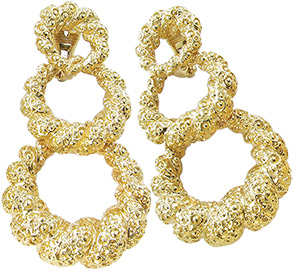|
Legacy
Better Than Expected
While some dealers came to the annual Miami antique show with low expectations, they left cautiously optimistic.
By Phyllis Schiller

|
|
Yellow gold textured rope-style earrings, circa 1965.
Photo courtesy Camilla Dietz Bergeron, Ltd.
|
With 100 dealers filling a ballroom dedicated to antique, estate and vintage jewelry, as well as many others spread throughout the show floor, the Original Miami Beach Antique Show 2016 was once again the scene of high-end luxury jewelry and gem horse-trading. According to the final figures, the show, held January 28 through February 1, was up 3 percent in attendance for all five days. And while some dealers experienced good traffic throughout, others felt it was less than usual. But ultimately, jewelry and gemstones changed hands among dealers and buyers from around the world and across the U.S.
“I thought the show was medium to good,” says Diana Singer, D&E Singer Inc., New York City. Gus Davis, partner, Camilla Dietz Bergeron, Ltd., New York City, says overall, he was quite pleased. “I was expecting less and was surprised at how well we did.” Jeff Russak, owner, Lawrence Jeffrey Estate Jewelers, Litchfield, Connecticut, says he found the mood more upbeat than 2015. He also rated the show as “moderately successful.”
By the end of the show, notes Jeff Cohen, N. Green & Sons, Chicago, Illinois, “people had a better opinion than going in. There was a very heavy presence of trade looking for loose and colored stones and loose diamonds and melee goods. We saw a lot of activity with fine, signed, well-made jewelry.”
What did have an effect on the show many dealers felt was the weakness of foreign currencies and the absence of the “usual” foreign buyers. “This year, the number of Asian buyers seemed to have dropped off,” says Janet Levy, principal, J. & S.S. DeYoung Inc., New York City. “The problems in China are the stock market and the loss of people’s net worth. Added to that is the anticorruption campaign that has been going on for a couple of years now and people are not moving their money and not spending their money.”
Those who did come, however, were there to buy. “The Chinese dealers were looking for coral and jade. And the European dealers were looking for pretty, salable goods at decent prices. And I think that they were not disappointed,” says Singer. “It was very much of a price-point show. Whatever people were buying, they wanted it to be a decent price or else they would let it go.”
People were negotiating, Levy says. “Sellers were realistic. While asking prices for splendid signed pieces were beyond what they’ve ever been, for everything else, if there was a willing buyer negotiating in good faith, deals were made.”
According to Levy, better goods sold quickly the first day or two, “mostly among the dealers,” and lower-end merchandise “sold to buyers there for bargains,” but the middle range is very soft. Agrees Davis, “What was not selling were the smaller items, lower to mid-range, that a lot of the stores if they’d had a good Christmas season would have come to restock.”
Singer says she saw a “huge resurgence in desire for wearable Victorian jewelry — long chains, bracelets, rings and earrings — as well as large chunky bracelets.” Also popular, she says, was yellow gold.
Russak says he sold “tasteful one-of-a-kinds and pieces with good colored stones. We did not sell all-gold or diamond-set pieces, which was a surprise.”
Levy found people were looking for diamonds and jewelry “more simple in styling, reflecting a more casual lifestyle, such as 1960s and 1970s jewelry.” Davis says dangling gold earrings and long necklaces from the 1960s and 1970s were popular, their more subdued look fitting in today.
While signed pieces were on everybody’s radar, Cohen sold “a lot of price-point antique jewelry — $50 up to $1,000 — that are within everybody’s reach.” He also says he noticed some activity once again in Art Deco platinum and diamond rings and earrings.
According to Davis, old diamonds sold — an old Asscher cut or cushion cut in an original mounting. Singer notes consistent interest in secondhand solitaires, a carat and up, as well as good-quality colored stone jewelry. “I sold almost all the aquas that I had,” she says. “I saw interest in pink tourmaline and colors that pop.” According to Levy, unheated rubies, Kashmir sapphires are trading “at the Cartier level. They’re going for more money than ever before.”
“I think this show was steady, and I expect the market will be the same over the next year,” opines Russak. Davis points out that the recent stock market dips and the fact that it is an election year are making people cautious. “People are buying, but not so much of the over-the-top things.”
Causing some consternation at the show was the fact that there will be a venue change to the Miami-Dade County Fair Expo Center next year while the Miami Beach Convention Center, which normally houses the show, is renovated. “There was a lot of negativity about the new venue,” says Davis. “But I’m positive about it. I think it will be very interesting. Miami is still the big show for the trade and it is a real pulse of the market.”
One thing this show made clear, says Cohen, is that the market is changing. “Prices have changed, in melee, in big diamonds. Some jewelry that had been bringing a good dollar is now a little soft.” But, Cohen sums up, “I think going forward, the future of our industry still looks good. These beautiful jewels and luxury goods have been bought, sold and traded for thousands of year. They’re not necessities but they’re what keeps life interesting. So people will indulge and buy, sell or collect them. And that’s what will keep the industry strong.”Article from the Rapaport Magazine - March 2016. To subscribe click here.
|
|